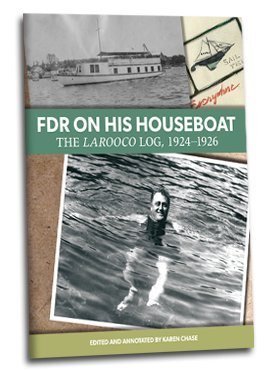FDR On His Houseboat: The Larooco Log
In the midst of the Jazz Age, while Americans were making merry, Franklin Delano Roosevelt was stricken by polio and withdrew from public life. From 1924 to 1926, believing that warm water and warm air would help him walk again, he spent the winter months on his new houseboat, the Larooco, sailing the Florida Keys, fishing, swimming, playing Parcheesi, entertaining guests, and tending to engine mishaps. During his time on the boat, he kept a nautical log describing each day’s events, including rare visits by his wife, Eleanor, who was busy carving out her own place in the world. Missy LeHand, his personal assistant, served as hostess aboard the Larooco. While FDR was sailing the Keys, the larger world was glittering. Chaplin, Gershwin, Hemingway, Fitzgerald, Bessie Smith, Louis Armstrong, Gertrude Stein, Frida Kahlo, Martha Graham—all were flourishing in the Roaring Twenties, but so were Stalin, Al Capone, and Hitler. The world went on as Roosevelt fished for mangrove snapper and drank martinis. Karen Chase presents FDR’s log entries, interspersed with photographs from the tumultuous outer world, to form a kind of timeline between two arenas—one man’s small private life full of struggle and fun, juxtaposed with the large public sphere. Chase gives us a side of FDR seldom seen before, revealing his wit, his penchant for practical jokes, and his zest for each day’s ordinary concerns in the context of his painful struggle to regain the use of his legs. For many decades FDR’s log has been virtually unknown to the public, appearing only once, in 1949, in his son Elliott’s four-volume collection of Roosevelt’s personal letters. The book also includes a facsimile of the original Larooco log.
Reviews
Excerpts
From the Introduction
During the Roaring Twenties, a politically ambitious young man who had been crippled by polio bought a houseboat so he could cruise the warm waters of the Florida Keys and try to cure his damaged legs. When Franklin Delano Roosevelt was stricken with the disease in 1921, he withdrew from public life. He spent three winters aboard his houseboat, from 1924 to 1926. While on the boat, he kept a log in longhand in a three-ring binder, writing in it almost every day. Sometimes he used black ink, sometimes turquoise, pages full of playfulness.
Grog in midst of glorious sunset
which was almost as poetic in coloring
as Frances’ and Missy’s nighties
So he documented one jolly evening. Or reporting on a broken motor:
Miami Engine doctor at work
Patient may respond to heroic treatment
A few years ago, I was working on a book about my girlhood polio, a book in which Franklin Delano Roosevelt looms large. Piled on the floor near my desk were four fat navy tomes of his letters. His son Elliott had edited these volumes of his father’s personal correspondence in 1949, four years after Roosevelt’s death during his fourth term as president. Having FDR’s words near me was inspiring and comforting. One day, I picked up one of the books and began trolling around. Buried amidst the letters, I stumbled on Roosevelt’s nautical log. His words were captivating. I loved his humor and language—— even the repetitive details——and wanted other readers to fall under his spell too. Thus this book.
Roosevelt had always loved boats and water. When he was five, in his first letter to his mother, he enclosed his drawing of sailboats. One night in August 1921, thirty-four years after he mailed that letter——after he boated, after he fought a forest fire and swam with his children in the Bay of Fundy——he was struck by polio. Roosevelt never walked again.
On August 28, the New York Times found it newsworthy to report his illness, though not its exact nature and seriousness.
Franklin D. Roosevelt Better
Franklin D. Roosevelt, former Assistant Secretary of the United States Navy, who had been seriously ill at his Summer home at Campobello, N.B. is recovering slowly. He caught a heavy cold and was threatened with pneumonia. Mrs. Roosevelt and their children are with him.
From then on, FDR tried treatment after treatment in his quest to walk again. Two years later, filled with hopes of healing, he rented a houseboat called the Weona and spent a month and a half in the Florida waters, fishing, relaxing, and entertaining guests. From the boat, he wrote his mother, Sara, “This warmth and exercise is doing lots of good,” and said his visiting guests “are great fun to have on board in this somewhat negligee existence. All wander around in pyjamas, nighties and bathing suits!”
For FDR’s health, his wife, Eleanor, felt compelled to visit the boat, but she disliked the blithe atmosphere. “I tried fishing but had no skill and no luck, when we anchored at night and the wind blew, it all seemed eerie and menacing to me.” She left the Weona after a few days.
In the summer of 1923, Roosevelt traveled from his home in New York to vacation with Louis Howe, his close political adviser, at Howe’s cottage on Horseneck Beach in Massachusetts. Missy LeHand, FDR’s assistant, stayed there too, taking care of correspondence. At the beach, Roosevelt tried out new regimens for his legs, working with a well-known neurologist, Dr. William McDonald, who had developed a strenuous course of treatment. FDR jokingly said that if he ever became president, the doctor would be the first visitor to the White House. Many mornings Howe brought him breakfast and said, “This is to make you strong. I will see that you become President of the United States.”
Sometimes Roosevelt went to the dunes in an old bathing suit, found a secluded spot, and crawled on his hands and knees over the hot sand until he was worn out. Back at the cottage, Howe would fix drinks for the two of them. Picture FDR sipping a martini and discussing politics, having just crawled across the beach. He didn’t mind crawling because he could do that himself. What he hated was for others to have to carry him from place to place.
One day that summer, his old college friend John Lawrence stopped by the Howe cottage for a visit. He and his wife had been guests on the Weona the winter before. There at Horseneck Beach, the men hatched a plan to buy a houseboat of their own for the coming winter months.

